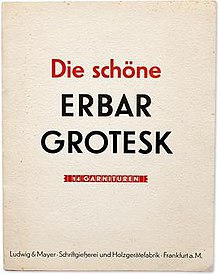Erbar (typeface)
 |
|
| Category | Sans-serif |
|---|---|
| Classification | Geometric sans-serif |
| Designer(s) | Jakob Erbar |
| Foundry | Ludwig & Mayer |
| Date released | 1922-30 |
| Re-issuing foundries | Linotype, Continental Type Founders Association |
In typography, Erbar or Erbar-Grotesk is a sans-serif typeface in the geometric style, one of the first designs of this kind released as type. Designer Jakob Erbar's aim was to design a printing type which would be free of all individual characteristics, possess thoroughly legible letter forms, and be a purely typographic creation. His conclusion was that this could only work if the type form was developed from a fundamental element, the circle.
Erbar was originally cast by the Ludwig & Mayer foundry of Frankfurt, Germany, with machine composition matrices later being offered by German and then American Linotype.Erbar was later exported to the United States and sold by the Continental Type Founders Association. A digital version is sold today by Linotype.
Erbar was cast in four weights with italic and condensed faces. Other variants were offered:
Light weight
Regular weight
Regular weight
Bold weight
Bold weight
Condensed weight
Condensed bold
The success of Erbar inspired the creation of many new geometric sans-serif faces by competing foundries including Futura, Metro, Vogue, Spartan and Twentieth Century among others. Of these, Futura proved to be the most successful and this, along with Jakob Erbar's early death, the small size of Erbar's Ludwig & Mayer Foundry and the international reach of Futura's Bauer Type Foundry, led to Erbar becoming less well-known than Futura.
Phosphor, an ultra-bold and inline display design similar to Erbar but released first was particular popular, and several imitations and revivals were created.
Zhurnalnaya roublennaya (Журнальная рубленая) or Journal Grotesque was a Russian sans-serif created in the Soviet Union by Anatoly Schukin and others, and released from 1947 onwards, quite loosely inspired by Erbar and with Cyrillic and later Latin characters.
...
Wikipedia
